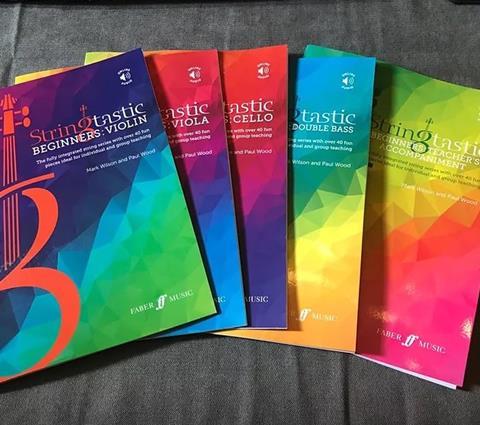Alex Laing reviews the latest teaching method from Faber, for violin, viola, cello and double bass

Stringtastic Beginners
Mark Wilson, Paul Wood
Violin: 40PP ISBN 9780571542239 £8.50
Viola: 40PP ISBN 9780571542247 £8.50
Cello: 40PP ISBN 9780571542255 £8.50
Double bass: 40PP ISBN 9780571542263 £8.50
Teacher’s accompaniment: 64PP ISBN 9780571542271 £11.99
Faber Music
Stringtastic Beginners is a set of 40 small compositions designed to take the young string player from open strings to using fingered notes from the D major scale. The volumes are designed to be flexible so that they work for the individual and also for any combination of strings including a string orchestra. The players can be accompanied on the piano (teacher’s accompaniment), or backing tracks can be downloaded.
The volumes are well organised with the first nine tunes introducing the players to all the rhythmic elements that follow. When all 40 tunes are learnt, it is possible for the players to return to the beginning and, for the first 20 tunes, to learn a duet part called the ‘Scaletastic’ part. It is good to note that Wilson and Wood adapt the writing for lower string parts, advising, for example, the position needed for the double bass.
There is no doubt that these volumes provide a welcome addition to the repertoire for young string players, especially in the group setting, but there are aspects that should have been given more thought and care. There are lyrics provided, ‘helping to develop a strong sense of pitch and rhythm’, but in several cases the words cut across slurring. This looks wrong on the printed page, could confuse pupils and teachers and, rather than help or reinforce the slurring technique, makes it counter-intuitive instead.
The authors have missed a valuable opportunity, in that no technical advice is given. The books have two cartoon pets, Spot the Cat and Dotty Dog, who appear on each page. Occasionally they say something in speech bubbles like: ‘Play me 4 bars before I sing.’ It would have been lovely and very useful to see nuggets of advice from these two characters, such as reminders about posture. They could also be employed to supply bits of information: a description of what a fanfare is, for instance. This would help spark a young musician’s imagination in other ways, and also support less experienced teachers using these volumes.
ALEX LAING











































No comments yet